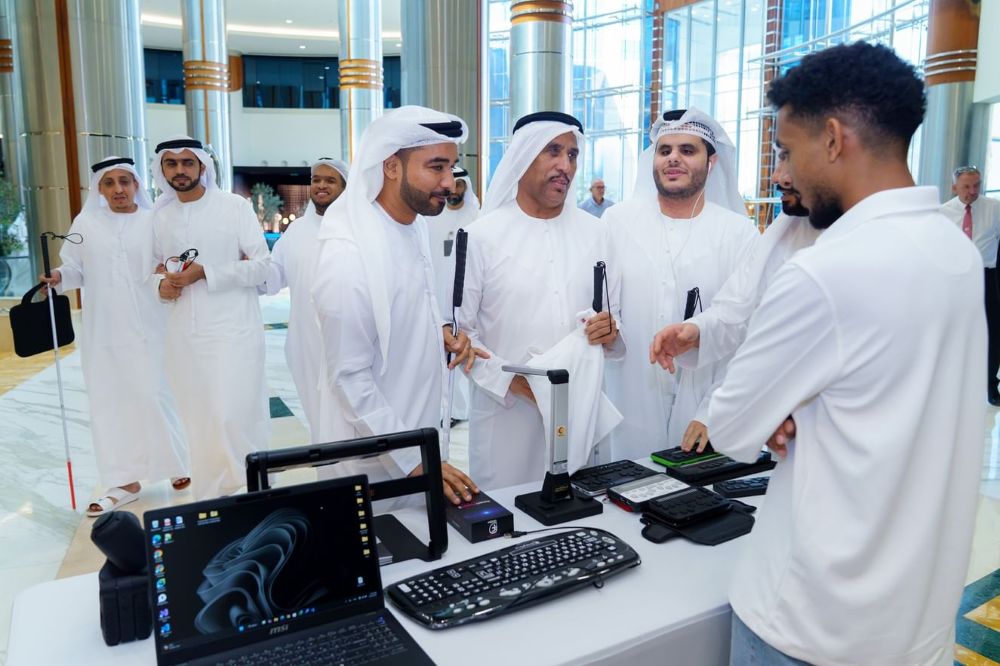Abu Dhabi
The National Library and Archives, in collaboration with Zayed Authority for People of Determination, celebrated White Cane Day, observed annually on October 15, by organizing a series of events

The National Library and Archives, in collaboration with Zayed Authority for People of Determination, celebrated White Cane Day, observed annually on October 15, by organizing a series of events and activities dedicated to people of determination who are blind or visually impaired. The initiative reflects both entities’ social responsibility and commitment to supporting and empowering this group to achieve full inclusion in society.
Empowerment and Awareness
Her Excellency Naema Abdulrahman Al Mansoori, Director of the Department of Blind Care at Zayed Authority for People of Determination, emphasized the importance of the white cane as a symbol of independence and self-reliance. She stated that celebrating this day reflects society’s awareness of the importance of supporting and empowering people with visual impairments across all aspects of life.
In her speech, Al Mansoori praised the continuous cooperation and support of the National Library and Archives for the Authority’s initiatives, affirming that such partnerships reflect the national institutions’ commitment to their responsibility toward people of determination. She highlighted that White Cane Day is one of the key global occasions in which the Authority is keen to participate to showcase the services and programs offered to the blind community.
She further noted that the positive engagement of the community with people of determination, and their participation in events and programs organized by the Zayed Authority, is a clear indicator of the cultural advancement and social awareness characterizing UAE society.
Knowledge Accessibility and Inclusion
Mr. Hamad Al Hammiri, Director of the Research and Knowledge Services Department at the National Library and Archives, welcomed the participants and commended the determination of people with visual impairments who have proven that willpower can overcome challenges and contribute actively to nation-building.
He noted that the white cane represents strength and perseverance, and explained that the National Library and Archives has paid special attention to people with visual impairments by printing a number of its national publications in Braille — including “Zayed: From Challenge to Union”, “Khalifa: Journey to the Future”, and “Qasr Al Hosn” booklets — as well as by providing devices that convert written texts into Braille, in line with the belief that everyone has the right to access knowledge.
Al Hammiri added that this celebration, held during the Year of Community, embodies the institution’s commitment to the national and humanitarian values established by the UAE’s wise leadership. He also commended the fruitful coordination and cooperation with the Zayed Authority for People of Determination.
Inspirational Voices and Experiences
During the event, Omar Al Amri, who is blind, spoke about the UAE’s legislative efforts to empower people of determination, reviewing Federal Law No. 29 of 2006 and the National Policy for Empowering People of Determination (2017), which focuses on health, social protection, family empowerment, and community participation.
Saif Al Falasi, Director of the Legal Affairs Department at Dubai Police, also shared his inspiring personal journey in education and professional life, affirming that family and community support played a crucial role in enabling him to achieve his ambitions and reach leadership positions.
Exhibition and Activities
On the sidelines of the celebration, an exhibition showcasing assistive devices and modern technologies designed for the blind was held at the National Library and Archives. It featured innovative tools that enhance accessibility and inclusion through advanced technology. The event also included a symbolic White Cane Walk, artistic and poetry performances, and interactive competitions that embodied the spirit of determination and social inclusion.
The event concluded with a guided tour of the Sheikh Zayed bin Sultan Al Nahyan Hall and the Sheikh Surour bin Mohammed Al Nahyan Hall, where the visually impaired guests explored historical documents and artifacts that chronicle the UAE’s union journey and highlight the nation’s achievements across different eras.
About the White Cane
The white cane is a mobility tool that enables blind individuals to move independently. It is held by extending the arm forward, allowing the cane to move one step ahead of the user’s leading foot. The cane stays in contact with the ground and should not rise more than two inches above the surface.
Types of White Canes
There are six types of white canes used globally:
Symbolic Cane: Used by the blind, visually impaired, and elderly to indicate visual difficulties, though it lacks the specifications required for mobility canes.
Guide Cane: Helps detect ground surfaces, curbs, and stair edges, offering protection for the lower body. It is usually slightly above waist height and made of nylon or aluminum.
Long Cane: The most used for independent travel. Its length reaches the lower rib cage, allowing the user to detect obstacles ahead. Tips are often made of nylon and shaped pointed, spherical, or conical.
Support Cane: Used by blind, visually impaired, and sighted individuals as a general walking aid, often made of durable wood for leaning.
Curved-Handle Cane: Shaped like a tennis racket, used on rough terrains or uneven surfaces, and extends above the lower rib cage.
Electronic Cane: A technologically enhanced cane resembling the long white cane, equipped with ultrasonic sensors that detect obstacles within five meters. Its tip is made of lead material, providing tactile feedback through gentle vibrations.
Would you like me to format this translation into a press release layout (with title, subtitle, and structured paragraphs for media distribution)?
Page Last Update: 15 October 2025
